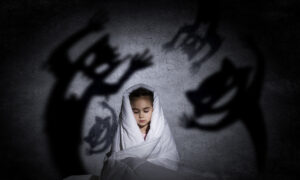It’s my favorite time of year again – spooky season! A time when we intentionally immerse ourselves in the eerie and the macabre, often without realizing the potential effects it can have on children and their sleep. While it’s all in good fun, the line between spooky and scary can sometimes be blurred, leading to nightmares and night terrors in our little ones. But fear not, you can be prepared to handle these nighttime frights. In this post, we’ll explore how to tell the difference between nightmares and night terrors, how to handle each of them when they occur, and strategies for avoiding them altogether this Halloween season.
Nightmares vs. Night Terrors
Let’s start by clearing up a common misconception: nightmares and night terrors are not the same thing. While they both involve nighttime sleep disturbances and are often scary for parents and children alike, they are actually two very different phenomena.
Nightmares:
- Nightmares are essentially bad dreams that can leave your child feeling frightened and upset.
- They generally occur during REM sleep.
- After a nightmare, your child wakes up, and they may come to you or call out reporting their bad dream and seeking comfort.
- They are often visibly upset, displaying signs of fear or distress.
- Your child can usually answer questions and participate in a conversation about the dream. They are fully awake at this point.
- Children usually remember the content of a nightmare the next day.
Night Terrors:
- Night terrors often occur between sleep stages and are like a “glitch” as the brain transitions between stages.
- During a night terror, your child may appear to be awake, but they are actually asleep. This can be confusing for parents, as the child’s eyes may be open, and they may seem to be moving around, talking, or making noise.
- If you try to ask a question or call their name during a night terror, your child is typically unresponsive.
- They may make loud noises, move restlessly, or seem agitated, which can be distressing for parents.
- Unlike nightmares, children experiencing night terrors usually have no recollection of the event the following day.

How to Handle Nightmares and Night Terrors
Understanding the differences between nightmares and night terrors is crucial because your approach to each should vary. The most important thing for both is to remember to stay calm, as that will help your child recover and get back to sleep quickly.
For Nightmares:
- Reassure your child that they are safe, that they were just having a dream, and that the bad dream is over. Don’t analyze or discuss the dream in depth. Save this for the next day if your child brings it up again.
- Replicate the end of the bedtime routine, have them use the bathroom, and tuck them back in just like you would at bedtime. Engage in soothing conversation to help them relax.
- Avoid feeding into their fears by checking under the bed or leaving lights on excessively. This can inadvertently reinforce their anxiety.
- Importantly, most children remember the content of nightmares the next day, so if they do bring it up, it’s okay to discuss it. Assure your child that bad dreams are normal and happen sometimes and it’s just our brain making up silly stories. Talk to your child about what made them scared about the dream, and reassure them that they are safe. Try not to make a big deal out of nightmares or analyze them after the fact.
For Night Terrors:
- Your primary concern during a night terror is to ensure your child’s safety. Remove any objects they might knock over and make sure they don’t fall out of bed.
- If a night terror is very disruptive or prolonged, you can gently wake your child by stroking their cheek or their foot, or gently shaking their shoulders. Allow them to go back to sleep quickly and try to avoid talking to them aside from a quick goodnight.
- There’s generally no need to talk about the night terror with your child, as they typically won’t remember it the next day.
Avoiding Nightmares and Night Terrors
Prevention is always the key when dealing with nighttime disturbances and sleep problems. To minimize the chances of nightmares and night terrors occurring, consider the following strategies:
- Practice good sleep hygiene, including a consistent sleep schedule and bedtime routine. Predictability and a sense of security can help prevent nighttime disturbances.
- Foster healthy sleep dependencies. Encourage your child to learn to fall asleep independently without relying on external factors.
- Limit exposure to frightening or developmentally inappropriate content. Be mindful of what your child watches or reads, especially close to bedtime.
- If your child becomes frightened by something, have an open and reassuring conversation. Explain why it’s not a real threat and emphasize their safety.
- End the evening with positive, happy activities that promote a sense of safety and calmness.
If your child experiences nightmares or night terrors frequently, or if you’re unsure about which is occurring, don’t hesitate to contact a sleep expert. They can provide guidance tailored to your child’s specific needs and help ensure everyone in the family enjoys a peaceful night’s sleep.